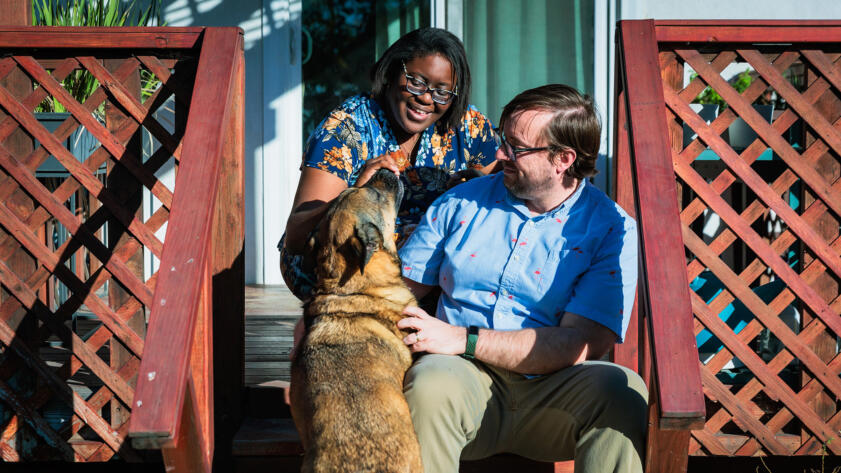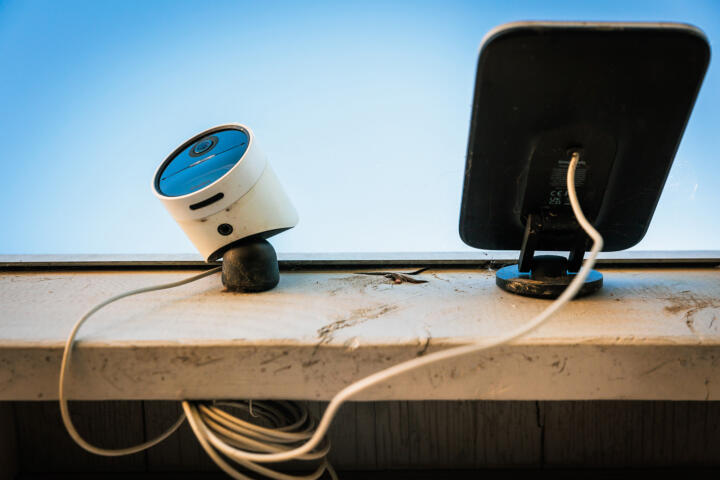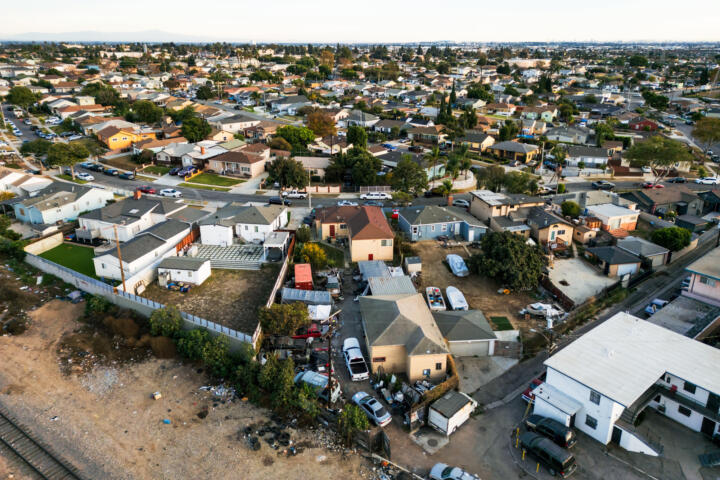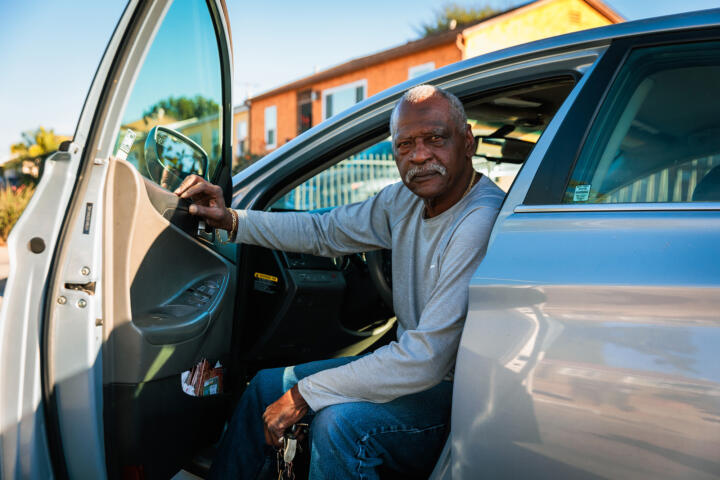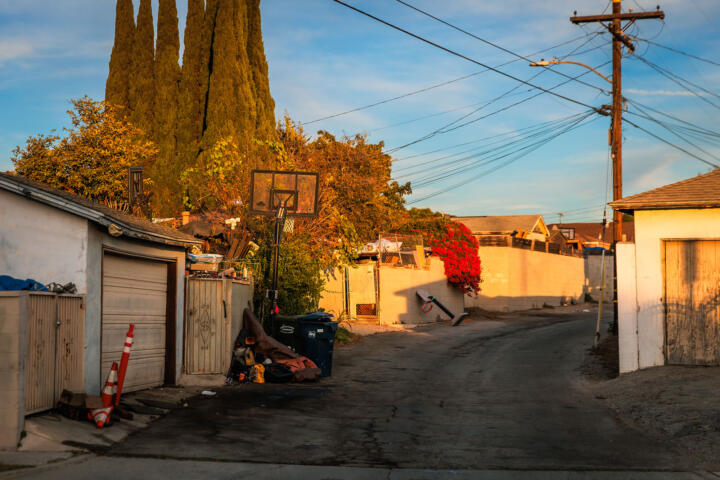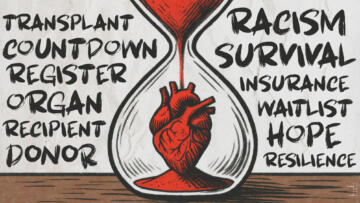This article was copublished with AfroLA, a nonprofit solutions journalism for Los Angeles told through the lens of the Black community. Sign up for The Breakdown newsletter here.
When my husband and I moved from Texas to Los Angeles in 2018, we had a very short window of time to find a place to live. We knew we wanted to buy as opposed to rent, and, much like an eager couple on an episode of House Hunters, we had some nonnegotiables: no HOA, no condo units on the ground floor (for noise and safety). After too many years schlepping to the laundromat in the snow when I lived in Maryland, in-unit laundry was a must. An alarm system was also a given, regardless of where we ended up.
Lam Thuy Vo’s recent Neighborhood Watch series about LAPD’s use of surveillance tech, including officers’ ability to access Angelenos’ Ring doorbell camera footage and crime alerts, resonated with me as a homeowner and a Black woman. We wanted our home security measures to include cameras, but I was adamant that would not include any Ring products. The fact that Ring was sued by users who were threatened, taunted with racial slurs and whose children were harassed was, well, alarming. We ultimately chose SimpliSafe with a home-monitoring plan. Even though Ring and SimpliSafe store video footage in the cloud, there were very important differences that factored into our decision. Ring stores video recordings up to six months by default versus 30 days with SimpliSafe, and then only as an opt-in feature.
I’d like to think I have a healthy paranoia about the eyes and ears of tech we use every day. Browser cookies and trackers watch our internet searches and monitor our online shopping carts to suggest products we might like. Virtual assistants like Siri listen even when we’re not talking to them. (Do you really think it’s a coincidence that you can ask Alexa a question about the weather for a sunny vacation spot and Amazon suddenly starts suggesting swimsuits you might like … in January?) And those terms of service we numbly agree to without reading? Sometimes our data is provided to companies for market research or sold to data brokers for better-targeted advertising we don’t even realize we’ve consented to. In my mind, the “Neighborhood Watch” reporting confirmed that my husband and I had made a good decision about a home security system.
We have five SimpliSafe cameras installed to monitor the entry points into our home, our cars parked in the driveway, and the backyard. Two of the cameras even have a motion-activated floodlight. There’s a SimpliSafe sign in the flower bed near the front door. We also have a 24/7 four-legged security guard: a German Shepherd mix who sheds pounds of fur and reliably alerts us to cat sightings and the mail carrier.
The South Los Angeles neighborhood we live in—a quiet enclave flanked by Inglewood, Gardena, and Hawthorne—has always felt safe. Neighbors know each other. When we walk our dog, we recognize nearly everyone along our usual half-mile-ish route on sight. For many folks, we know names, jobs, kids, pets … even birthdays.
We come together when we have to.
When there was a fire in the homeless encampment behind our house, our little community sprang into action. One person talked to 911 operators to explain how the fire department could access the area behind the railroad tracks to get to the fast-spreading fire. Another neighbor drove through the neighborhood honking his horn to wake everyone up. (It was 3:30 a.m.) I knocked on the doors of neighbors I knew had medical issues and would need more time to leave their homes. The fire was extinguished, no one was hurt, and no homes were burned.
My neighbors and I have also been forced to band together when we shouldn’t have had to—when it’s really counted, when lives were endangered, we were left to figure things out for ourselves.
Our neighborhood is under the jurisdiction of the Los Angeles County sheriff. Our little stucco house is 0.6 miles—a two-minute drive—from the South Los Angeles Sheriff’s Station. But you never know what you’re going to get when you call the police to our neighborhood.
My neighbor Pedro Castellaños, an auto mechanic who lives two streets over, summed it up well as he told me about a time he called the police:
There was a strange guy walking around. I don’t know if he was on drugs or something, but he was acting very suspicious. I call the cops, and they’re like, “You know, we’re gonna be there as fast as we can. But we have other things. And, you know, we’re low on cops. We’re sort of low on budget right now. We don’t take calls right now” for this and this and that. So since then, there’s no real point calling them. They take forever to get here anyways.
And sometimes they don’t show up at all. This past summer, I helped another neighbor assist the cops in finding his stolen car, using information from his home’s security camera footage he was able to give them.
Rodney Winslow, 65, his older brother, and their feisty 87-year-old mom live two doors down. They’re part of the family my transplant husband and I don’t otherwise have in Los Angeles. On July 3, Rodney appeared on my doorstep in a panic; his Hyundai Elantra, which had been parked down the block, was stolen off the street in broad daylight. The car was full of paperwork and materials he needed for school. (He’s on track to graduate from an addiction counselor certification program next September.) He wanted to know if our cameras caught the thieves. I searched through the SimpliSafe app’s timeline on my phone but couldn’t find anything useful. So I went to the neighbors who lived across the street from where his car was parked. They have a Ring doorbell camera. It did pick up the spot, but the view during the time it was stolen was blocked by some equipment and a truck that belonged to a construction crew that had been working at their house. A Ring doorbell camera on the house next door also missed the theft.
As a last-ditch effort, I helped Rodney check his own cameras. He installed four cameras in 2019 after he was chased, pistol-whipped, and robbed on our street. As we reviewed the feeds from cameras facing the front of the house, we saw it: Two men dressed in jeans jumped out of a car driven by a third person. One thief cracked the driver’s-side lock, they hopped in, and both cars sped away in opposite directions. Everything went down in less than 30 seconds. Our neighbors’ construction workers confirmed they saw two men in reflective vests around the time the car disappeared. I took stills of the recording that Rodney used to give a detailed account to the police.
He had called the police as soon as he realized his car was gone. The dispatcher told him sheriff’s deputies would come out. “They just didn’t come,” he said. After more than two hours, he drove over to the sheriff’s station in his other vehicle to file a report. East L.A. officers called him the following day. “Your car has been recovered. We arrested two people,” Rodney recounted the officer saying. The car was damaged but not destroyed. Insurance paid for repairs and covered the cost of the items that had been stolen.
This particular story does at least have a happy ending. We precipitated our own justice. But that hasn’t always been the case in my neighborhood.
There’s a long alley behind Pedro’s house. He and a neighbor at the end of the block check their cameras to monitor the alley for vandals. “We’re trying to just keep it safe,” he said. When he sees “young taggers” painting graffiti, he takes it upon himself to power-wash it off. “You know, I work on my cars [back here]. I never want [the neighbors] to think it was my crowd coming over here and, like, [messing] up or something, you know?”
According to CrosstownLA, a nonprofit newsroom that reports on “LA by the numbers,” my neighborhood ranks among the 20 lowest in terms of crime rate, at about 11 crimes per 100,000 people. My neighborhood feels safe compared to bordering areas where crime rates are higher, around 550 to 680—but even that isn’t terrible compared to Downtown L.A., which tops the list at nearly 3,200.
Despite the neighborhood’s relative safety, we’ve had several serious incidents, including a fatal shooting in summer 2021.
The last time I saw my beloved neighbor (whose name and relatives’ names I’m withholding out of respect) was a week before he died. It was the 4th of July; he was goofing around at a barbeque in a flag-patterned outfit. His then-5-year-old daughter, who loves our dog and shares my birthday, was jumping in a bounce house rented for the party. Her dad prepped sparklers to light nearby.
Around 10 p.m. on July 10, he arrived home while his wife, child, and father-in-law were out at dinner celebrating the latter’s birthday. Neighbors, including myself, heard explosions and thought they were fireworks; they were actually gunshots as our friend, 34, was shot multiple times in his driveway. He jumped out of his car to run into the house, fleeing someone who opened fire from another car. I remember being told a few days later that my friend, who had a smile for everyone, bled on the pavement. A neighbor from across the street rushed to help him and call 911. She gave him CPR for what “seemed like forever” until paramedics arrived. I was told that in the time it took sheriff’s deputies to show up, family members from 20 minutes away had arrived.
Pedro has lived a few houses down from my neighbor’s family since 2015. He wasn’t home when the shooting occurred. But he did have four security cameras installed. None of them caught the shooting. “When that happened, I was like, no, I really need more [cameras] here.” Today, Pedro has eight security cameras. As we stood and talked over an engine Pedro was working on, his voice sounded regretful: “My wife called me, and she thought it was just fireworks. I didn’t have a camera at the time pointing [in that direction]. I mean, if that camera was there a little bit earlier, maybe something different would have happened. I don’t know if the guy ever got caught.”
To my knowledge, my friend’s family was never contacted about any arrests being made. Shortly after the shooting—after neighbors patched bullet holes in the house’s stucco and scrubbed blood off the concrete, after the flowers wilted in the makeshift memorial on the driveway—his family installed a Ring doorbell camera.
Last month, I was walking our dog. A dark-colored SUV came barreling past us. We heard a crash farther down the block, near the homes of Pedro and my deceased friend. As I neared the end of the street, my friend’s father-in-law was standing with his granddaughter on the porch talking to Pedro, who was moving debris from the crash out of the street. The SUV had struck an ice cream truck, which had been rounding the corner, before taking off. The SUV’s front bumper had fallen off. My neighbors and I stood debating what to do next.
We tossed around the idea of calling the police so they could dust the bumper for fingerprints. We decided not to bother. Hoping we could find a license plate number, Pedro said, “Let me check my cameras.”
